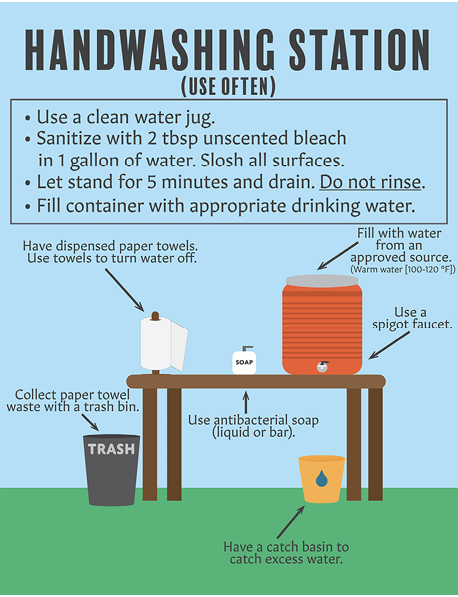Tailgating Food Safety
Tailgating can be a year-round social gathering—a time for family and friends to celebrate their team with food and fun. Since tailgating is an outdoor event with many people being served, this fun gathering can become threatening if appropriate food-safety guidelines and practices are not followed.
Clean and Sanitize
To help prevent foodborne illnesses, wash your hands with warm, soapy water for at least 20 seconds before and after preparing foods. If there is no access to running water at the tailgate, come prepared with water, soap, and paper towels for a handwashing station. Bring moist towelettes and hand sanitizer (at least 60 percent alcohol) for sanitizing hands and surfaces. Hand sanitizer and moist towelettes are good in a pinch, but remember that there is no effective substitute for soap and water for handwashing and cleaning. Handwashing is also important before eating food, after using the restroom, after touching garbage, and after blowing your nose, coughing, or sneezing.
Avoid Temperature Abuse
Most bacteria that cause foodborne illnesses thrive in the “temperature danger zone”—between 40°F and 140°F. Keep this in mind when packing coolers to transport to the tailgate. Use ice, ice packs, or a refrigerator to keep foods cold. Pack drinks in a separate cooler from food products because the drink cooler will be opened and closed frequently, causing the temperature to rise inside the cooler. On the drive, keep the cooler in an air-conditioned passenger compartment; never place a cooler in a hot trunk where foods can rise to the temperature danger zone.
To limit the growth of bacteria in cold foods when serving, keep foods below 40°F using an ice bath, and keep foods covered. Store food in the cooler after all guests have been served. To limit the growth of bacteria in hot foods, keep them above 140°F using chafing dishes or crock pots. All foods kept at room temperature for more than 2 hours should be thrown away. If the temperature at the tailgate is above 90°F, foods left out should be discarded after 1 hour. This also includes hot take-out food. Always observe the food safety mantra—“when in doubt, throw it out!”
Prevent Cross-Contamination
Packing smart is an easy way to prevent cross-contamination. Raw meat, poultry, fish, and seafood should be wrapped, sealed, and placed in the bottom of the cooler—this ensures that raw juices do not drip onto ready-to-eat foods.
Thermometers are highly encouraged if you plan on grilling at the tailgate. After each use, it is important to clean thermometers used to check temperatures of meat and other food products. For buffet-style tailgates, provide clean tongs and utensils so that guests do not cross-contaminate the food with their hands.

Figure by Thaddeus Crist; recreated from North Carolina State University Extension.
.png)
Figure by Thaddeus Crist.
Grill Safely
Safe grilling begins with safely thawing frozen items. Keep thawing meat out of the temperature danger zone and below 40°F. This can be accomplished by thawing in cold water, in the refrigerator, or in the microwave (but only for immediate use). Never thaw meat on the kitchen counter, in hot water, or in the trunk of the car on the way to tailgate because this is in the temperature danger zone (above 40°F and below 140°F). For the same reason, marinate foods in the refrigerator, not at room temperature. Before adding raw meat to the marinade, save some for dipping or basting; do not reuse marinade after it has been in contact with raw meat, poultry, fish, and/or seafood. Do not partially cook meat, poultry, fish, or seafood to grill or cook later. Partially cooking muscle foods puts them in the temperature danger zone, which allows bacteria to grow rapidly.
After transferring raw meat to the grill, change out the utensils (tongs, forks) and container (plate, dish, platter) used for the raw product to prevent cross-contamination from raw meat. Do not put cooked food in the same container that held raw meat, poultry, fish, and/or seafood because the raw juices could contaminate the cooked product. Always use a clean thermometer to check the internal temperature of cooked meat, regardless of appearance, since color is not a guaranteed indication of doneness. Be aware of the safe minimum internal temperature of the foods being prepared (Table 1).
Use the Proper Thermometer Correctly
Instant-read dial thermometers or digital thermometers are the best options for a tailgate. Both are small and relatively fast, and most brands are easy to calibrate. To ensure accuracy, calibrate the thermometer periodically. In ice water, thermometers should read 32°F; in boiling water, they should read 212°F. Infrared thermometers are not appropriate for measuring the internal temperature of food items because they are designed to measure surface temperature.
To check the internal temperature of any food product, insert the thermometer into the thickest, coldest part of the food and hold there until the reading stabilizes. The minimum internal temperature for sausages, bratwursts, and beef hamburgers is 160°F; 165°F for hotdogs, poultry, and reheated foods; and 145°F for a medium steak (Table 1).
*As measured with a food thermometer before removing meat from the heat source. For safety and quality, allow meat to rest for at least 3 minutes before carving or consuming. You may choose to cook meat to higher temperatures based on personal preference.
|
Product |
Temperature |
|
All poultry |
165°F |
|
Ground meats (beef, pork, lamb, and veal) |
160°F |
|
Hotdogs, bratwursts, sausages, burgers |
160°F |
|
Beef, pork, lamb, and veal (steaks, roasts, chops) |
145°F* |
|
Fish and seafood (shellfish) |
145°F |
|
Leftovers, reheating |
165°F |
Source: United States Department of Agriculture (USDA) Food Safety and Inspection Service (FSIS). Tailgating Food Safety Q&A. Available at: https://www.fsis.usda.gov/food-safety/safe-food-handling-and-preparation/food-safety-basics/tailgating-food-safety-q
Leftovers
While tailgates can last for hours, improperly stored foods cannot. Food that is unrefrigerated or improperly held can cause foodborne illnesses. Remember it is important to store perishable food in the cooler except when serving. Cook only the amount of food needed at a specific time to avoid the challenge of keeping leftovers out of the temperature danger zone.
Discard any leftovers that are not cold (40°F or below) after the game. Food should not be left out of the cooler or off the grill more than 2 hours (1 hour when the outside temperature is above 90°F).
Summary
Cooking and storing foods properly at a tailgate is important to avoid potentially getting sick from harmful bacteria. Bacteria on food cannot be seen by the human eye, so preparing, cooking, and storing foods properly—especially at a tailgate—is vital.
References
Centers for Disease Control and Prevention. When and How to Wash Your Hands. Available at: https://www.cdc.gov/handwashing/when-how-handwashing.html
North Carolina State University. Handwashing Station. Available at: https://foodsafety.ces.ncsu.edu/
United States Department of Agriculture (USDA), Food Safety and Inspection Service (FSIS). Tailgating Food Safety Q&A. Available at: https://www.fsis.usda.gov/food-safety/safe-food-handling-and-preparation/food-safety-basics/tailgating-food-safety-q
Resources
Centers for Disease Control and Prevention
Partnership for Food Safety Education
U.S. Department of Health and Human Services
United States Department of Agriculture (USDA) Food Safety and Inspection Service (FSIS)
The information given here is for educational purposes only. References to commercial products, trade names, or suppliers are made with the understanding that no endorsement is implied and that no discrimination against other products or suppliers is intended.
Publication 3328 (POD-06-22)
By Courtney Crist, PhD, Associate Extension Professor, Food Science, Nutrition, and Health Promotion. Prepared by Kimberly Coon, Graduate Research Assistant; Madeline Roth, Undergraduate Extension Assistant; and Morgan Von Staden, Graduate Research Assistant.
The Mississippi State University Extension Service is working to ensure all web content is accessible to all users. If you need assistance accessing any of our content, please email the webteam or call 662-325-2262.



